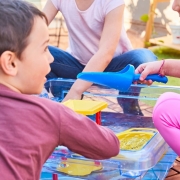How Sensory Learning Can Help Teach Children with Disabilities
Disability Education
Children with physical or intellectual disabilities have a right to receive special educational provisions. This is defined as “educational or training provision that is additional to, or different from, that made generally for other of the same age” in mainstream settings. Essentially, special provisions or adaptations should be made to give disabled children the opportunity to participate in classroom activities and learn as effectively as their able-bodied or neurotypical peers.
Whilst UK parents can apply for an EHCP (Education, Health and Care Plan – known as Individualised Education Plans in the USA) that will identify what educators must put in place to support a disabled child’s learning at school, it is often little or no guidance for how parents can support their child’s learning at home.
As a parent of a child with a disability, the constant reminders that your child faces so many struggles can be heart-breaking. Finding ways to support their development and learning at home is a fantastic way to help your child reach their full potential but knowing where to start is often overwhelming. Children with learning disabilities often play and learn differently to neurotypical children and parents can feel clueless about where to start.
All children learn through play, and disabled children are no different. The key is to find the right supports and opportunities for disabled children to learn through play and have fun doing it.
Sensory Play
Sensory play is any activity that stimulates the senses. There are five main senses: sight, sound, smell, taste, and touch, and two other less-known senses, vestibular (sense of balance) and proprioceptive (sense of where each body part is in relation to the rest of the body). The more kids use their senses, the more they develop them and the ability to learn using them.
Sensory play is essential for kids to learn how their bodies work, and how to process and interpret the world around them. This is useful for all children but especially important for students with special needs.
How can Sensory Play Help Children with Disabilities Learn?
- Retaining New Ideas – Processing disorders, such as autism, impair how the brain receives and retains information. Engaging multiple senses when learning something new makes it more likely that the child will be able to remember and recall information later. Using toys like tactile shells engages sight, sound, and touch senses to teach concepts of symmetry, matching, comparing patterning, and counting. Making learning into a playful experience also helps children with impaired attention skills stay focused and more engaged.
- Speech and Language – Sensory play is excellent to build language skills for those children with speech and language difficulties as it provides natural chances for children to describe how the sensory activity feels as they experience it, helping them practice their descriptive vocabulary.
- Social Skills – Children with disabilities often feel alienated or isolated from their classmates, and the irony is that children without additional needs may feel apprehensive approaching a child who looks or acts different than they do. Sensory play can be a group activity that breaks down these barriers and promotes social interaction. Setting out fun challenges like the step a trail entices kids of all abilities to investigate, the first step to interaction and even friendship.
- Motor Skills – Whether kids are making waves in a water tray, or threading beads they are strengthening their muscles, practicing hand-eye coordination and developing dexterity – brilliant for children with dyspraxia, cerebral palsy, hypermobility, and more.
- Satisfying Sensory Needs – Children with sensory processing disorders can either need extra sensory feedback or find sensory feedback too overstimulating (or a combination of the two – oversensitive to loud noises or bright lights, for example, but finding firm touch or different textures soothing). This is where consideration needs to be made for the individual sensory needs of each child. If there’s one thing special education teachers learn quickly, is that it pays to be adaptable and creative.
Children with sensory seeking needs may enjoy activities that encourage movement, such as trampolining or the whizzy dizzy, great exercise as well as being fun and working on gross motor skills. This also works on the vestibular and proprioceptive senses – beneficial for many children with disabilities.
Children who are hypersensitive to different textures may find it hard to enjoy art as it often involves getting messy. Geo Stampers are a ‘clean’ outlet for creative expression, allowing children with sensory issues the opportunity to exercise their creativity and imaginations like their neurotypical peers.
The great news for educators and parents alike is that sensory play benefits all children, not just those with additional needs. Provisions you put in place to make learning more accessible for those who need extra help will not hinder those that don’t in any way; in fact, it helps them too.
It is important to remember that incorporating opportunities for sensory play is a fantastic way to enrich the learning environment for all children.



